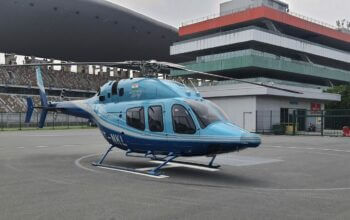Estimated reading time 6 minutes, 51 seconds.
With air travel demand forecast to outpace the current capacity of the region’s airports, a group of 11 Southern Ontario airports have responded with the launch of the Southern Ontario Airport Network (SOAN) at an event on May 9. The group, comprised of 11 of the region’s most commercially significant airports, is dedicated to making sure the growing demand for air travel in Southern Ontario, which is expected to reach approximately 110 million passengers by the early 2040s, is supported.

“Our forecast tells us that by 2043 aviation demand will be around 110 million passengers. When we look at what the current capacity amongst airports in the region, we would be leaving 20 million passengers ‘on the table’ if we don’t take action now,” said Howard Eng, president and chief executive officer of the Greater Toronto Airports Authority. “Thankfully, we have a network of great airports, who have come together to start brainstorming ways to capitalize on this incredible opportunity.
“We know that the efficient movement of people and goods to and from our region is an important part of Canada’s broader supply chain, and that we have a role in enabling economic prosperity through our actions and investments. As we look to the future of this growing region, we know that each of our airports can play a greater role in supporting our local and regional economies.”
Members of the Southern Ontario Airport Network include: Toronto Pearson International Airport, Billy Bishop Toronto City Airport, Hamilton John C. Munro International Airport, Kingston/Norman Rogers Airport, Lake Simcoe Regional Airport, London International Airport, Oshawa Executive Airport, Niagara District Airport, Peterborough Airport, Region of Waterloo International Airport, and Windsor International Airport. Transport Canada and Ontario’s Ministry of Transportation are also important contributors to SOAN’s work.
“Billy Bishop Airport has experienced incredible growth over the last 10 years and made significant investments in infrastructure and services to ensure the airport can continue to serve as an important gateway to/from eastern Canada and the U.S. and a valuable asset for the City of Toronto,” said Gene Cabral, Billy Bishop Toronto City Airport. “The paper released today indicates that there is great opportunity associated with an airport network for Southern Ontario that can address growth in the region and future demand for aviation through collaboration. For its part, Billy Bishop Airport is exceptionally well positioned to continue to play its part as it already specializes in regional travel and has a managed growth strategy in place to ensure it can support Pearson and the future travel needs of Ontarians while focused on other airport services such as medevac and personal aviation while remaining in balance with the community in which it is located.”
Among the short-, medium- and long-term goals of the SOAN are:
- Completing an economic analysis of the impact of the Southern Ontario Airport Network for our communities, the region and the province;
- Understanding the ground transportation needs in Southern Ontario and advocating for investment in ground transportation improvements that will reduce congestion and greenhouse gas emissions; and
- Developing best-in-class strategies for responsible and sustainable airport growth including community engagement and noise management.
In conjunction with the launch event, the SOAN released a statement of intent titled, “Flying Together: The Southern Ontario Airport Network.” The paper emphasizes that planning for growth in a responsible way is essential; without it, the region could potentially leave $15 billion in GDP on the table and force more than 20 million passengers to look elsewhere for their air travel needs.
“As Toronto Pearson becomes a mega hub airport, network airports in the Greater Toronto Horseshoe Area like Hamilton International are ready to serve the growing passenger and cargo traffic demand with significant available low cost capacity,” said Vijay Bathijya, Hamilton John C. Munro International Airport. “In addition, connectivity options like the new shuttle service that we announced today simply enhances connectivity between our two airports with regular service to allow for seamless travel options for the customers.”
The members of the SOAN recognize that the region has the potential, given its many air transportation assets, to meet the growing demand for air travel. Through responsible planning, the SOAN will ensure that the region is well placed to keep the jobs and economic benefits of air service demand in Southern Ontario.
“Kingston Airport’s vision is to provide effective air services for the region and the community’s businesses, institutions and residents by providing them with the air services they require and to foster the continued growth of our general aviation partners. In working closely with the GTAA within the network of regional airports, we expect that the SOAN initiative will create opportunities that could in turn generate new economic activity at our airport and in our community and region,” said David Snow, Kingston/Norman Rogers Airport.
The full statement of intent is available online.








